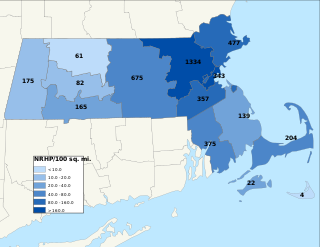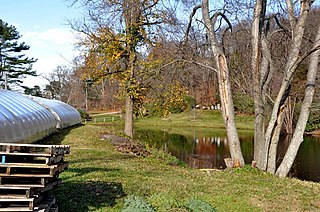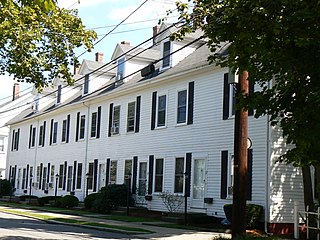
The National Register of Historic Places is a United States federal official list of places and sites considered worthy of preservation. In the state of Massachusetts, there are over 4,300 listings, representing about 5% of all NRHP listings nationwide and the second-most of any U.S. state, behind only New York. Listings appear in all 14 Massachusetts counties.
The following properties are listed on the National Register of Historic Places in Arlington, Massachusetts.
This National Park Service list is complete through NPS recent listings posted June 14, 2024.

Allandale Farm, also known as the John Harris House and Farm, and once as Faulkner Farm, is an historic farm at 284 Newton Street in Chestnut Hill, Massachusetts. The main farm house, built c. 1778 and extensively remodeled in 1976, is one of Brookline's few 18th-century houses. The farm is the last working farm in both communities; it was added to the National Register of Historic Places in 1985.

The Wheeler-Minot Farmhouse, also known as the Thoreau Farm or the Henry David Thoreau Birthplace, is a historic house at 341 Virginia Road in Concord, Massachusetts, United States. It is significant as the birthplace of writer Henry David Thoreau. The house was listed on the National Register of Historic Places in 2004. It currently serves as a historic house museum and is open to the public.

The Col. James Barrett Farm is a historic American Revolutionary War site in Concord, Massachusetts, associated with the revolution's first battle, the 1775 battles of Lexington and Concord. His farm was the storage site of all the town of Concord's militia gunpowder, weapons and two pairs of prized bronze cannons.

The Martin House and Farm is a historic farm at 22 Stoney Hill Road in North Swansea, Massachusetts. The main house is a 1+1⁄2-story gambrel-roofed wood-frame structure, with a crosswise ell at the rear. The oldest portion was built in 1728 by John Martin, as a single pile structure with a gable roof. It was soon afterward extended with a kitchen space, and was enlarged about 1814, when the gambrel roof was added. The property was farmed by Martin's descendants until 1934, when the property was bequested to The National Society of the Colonial Dames of America. The house is operated by the Dames as a historic house museum. It was listed on the National Register of Historic Places in 1978.

The William B. Sherman Farm is a historic farmhouse located at 1072 State Road in North Adams, Massachusetts. Built in the 1820s, it is one of the city's few surviving 19th-century houses, with relatively few alterations since its elaborate Italianate porch in the 1870s. It was listed on the National Register of Historic Places in 1985.

The Harris Farm is a historic late First Period farmhouse in Marblehead, Massachusetts. It is a rare example of a three-bay house from that period. It was built c. 1720 as a two-story structure with one room on each floor, and an integral leanto section in the rear. The leanto section was later raised to a full two stories and the roof was rebuilt. Further additions in the 1950s added converted 19th-century sheds to the rear of the house, and the front door was replaced with a Colonial Revival style door.

The Peirce Farm Historic District is a small historic district within the Arlington Heights neighborhood of the town of Arlington, Massachusetts. The district features three houses that are in a transitional style between Federal and Greek Revival styles, dating from the 1830s. The houses are located at 122 and 123 Claremont Avenue, and 178 Oakland Avenue. These three houses were all built by members of the Peirce family, who were among the earliest settlers of the Arlington Heights area, and owned much of its land into the late 19th century.

The Warren Rawson House is a historic row house at 37–49 Park Street in Arlington, Massachusetts. This utilitarian wood frame rowhouse was built c. 1885-90 by Warren Rawson, a leading farmer in Arlington, to house farm workers. It is one of only a few such multiunit buildings to survive in the town. The rowhouse was listed on the National Register of Historic Places in 1985.

The Robinson-Lewis-G. F. Fessenden House is a historic house in Arlington, Massachusetts. The 2+1⁄2-story wood-frame house was built c. 1850, and is a well-preserved Italianate style house, with ornate bracketed window surrounds, and a gable-roofed front porch with dentil moulding and full pediment. It was built as a farmhouse in an area that was not developed as a residential subdivision until later in the 19th century, and only had a few houses prior to that development.

The Hovey-Winn House is a historic house at 384 Main Street in Winchester, Massachusetts. The 1+1⁄2-story Greek Revival cottage was built c. 1841 by John Coats, a local housewright who built a number of houses along Main Street. It is one of a small number of local houses with a side gable roof that overhangs a full-width Doric porch. The house in the 19th century had a number of locally prominent individuals, include Reverend William Eustis, druggist Josiah Hovey, and Hovey's son-in-law Denis Winn, who owned the town's first livery stable.

The Sanderson–Clark Farmhouse is a historic farmstead at 47 Lincoln Street in Waltham, Massachusetts. The property includes an 1831 Federal style house, along with farm-related outbuildings, including a barn and stable. The property was used as a working farm until the early 20th century. It is now surrounded by 20th-century infill development, although other Federal-era houses associated with the Sanderson family still stand nearby.

The Suell Winn House is a historic house at 72-74 Elm Street in Wakefield, Massachusetts. The house was built c. 1805 for Major Suell Winn, a local farmer, and is one of the best representatives of Federal-style architecture in Wakefield. It is a 2+1⁄2-story wood-frame structure, with two interior chimneys, a five-bay facade, and an elegant doorway with sidelight windows and an architrave. An ell extends the house to the right. Winn, a native of nearby Burlington, was killed crossing the railroad that divided his landholdings, after attending a town meeting where he protested the need for improved crossing signals at that location.
Smith Farm or Smith Farmhouse or variations may refer to:

The Cherry Hill Farmhouse is a house museum in Falls Church, Virginia, United States. Built in 1845 in a Greek Revival architecture style, it belonged to wealthy farmer families until 1945, and in 1956 it became property of the City of Falls Church, which transformed it into a museum, as a historical building. Today, the Cherry Hill Farmhouse, along with other five such constructions in Falls Church City, is part of the National Register of Historic Places, as an important testimony of 19th century Victorian buildings in the area.

The Brown-Davis-Frost Farm, now called Lantern House Farm, is a historic farm property at 17 Whitney Street in Jefferson, a village of Holden, Massachusetts. It has a history dating to the 18th century, and includes one Holden's oldest brick houses. The property was listed on the National Register of Historic Places in 1995.

True Farm is a historic farm and summer estate in Holderness, New Hampshire. Located off New Hampshire Route 113 on True Farm Road, the farm is based around a c.1820 farmhouse, and was expanded into a summer estate in 1920 by George Saltonstall West. The 100-acre (40 ha) estate includes numerous outbuildings and a lakefront cottage. The farm was listed on the National Register of Historic Places in 2012.

Oak Grove Farm is a historic First Period farmstead in Millis, Massachusetts. The 2+1⁄2-story wood-frame farmhouse was probably built in three phases, the first of which was in the early 18th century. Around this time, the left five bays of the house were built, as was a central chimney. In the second quarter of the 19th century, three bays were added to the right, giving the building its current asymmetrical eight-bay facade. Finally, in 1884 a series of modifications and additions were made. The central chimney was removed, a leanto section was added to the rear of the house, and the front porch was added. A second porch was also built onto the rear ell around this time.

The Isaac M. Raymond Farm, now Uphill Farm, is a historic farm property on North Bridgewater Road in Woodstock, Vermont, United States. The farm is the reduced core of a larger farm property accumulated in the first half of the 19th century by Isaac Raymond, and revived as a gentleman's farm in 1940. The property includes an altered 1805 Cape style farmhouse and 20th-century Colonial Revival farm buildings. It was listed on the National Register of Historic Places in 1993.





















